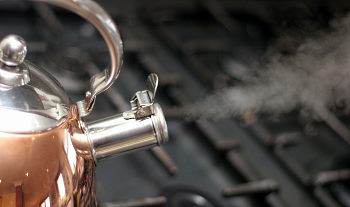property>heat of vaporisation
What is Heat of Vaporisation?

In thermo-chemistry, the heat of vaporisation is more commonly known as the enthalpy of vaporisation. This is the net change in enthalpy required to cause a given quantity of some liquid to undergo a phase change and become a gas. The SI units for enthalpy of vaporisation are KJ/mol, which reflects that they are an amount of energy needed per amount of substance in order for a phase change to take place.
Typically, the enthalpy change required for a liquid to change to a gas also has to factor in the enthalpy change necessary to raise the temperature of the substance to its boiling point. For example, if we were to transform an ice cube into water vapour, we would have to first melt the ice and then raise the temperature of the water from the ice to 100 degrees Celsius before it will transform into a gas. The enthalpy of vaporisation, then, is the change in enthalpy required to get the liquid water to 100 degrees Celsius and then to transform into water vapour.
Assuming we have a liquid at a certain temperature, its heat of vaporisation can be expressed in the following way:
ΔHVaporisation = ΔHraise to boiling + ΔHVaporisation at boiling
In most applications of chemistry one calculates the enthalpy change necessary to get the substance to its boiling point and then factors in the enthalpy change for the phase transition at the substance’s boiling point. That is why it is very common to see measurements of the heats of vaporisation for many substances at their boiling points. It may be confusing at first. Just make sure you check to see that the heat of vaporisation you are looking at is the one associated with the boiling point.
The heat of vaporisation must vary with temperature because a substance must first get to its boiling point before it vaporises, and this requires a change in enthalpy. However, for very small temperatures close to zero kelvin, the heat of vaporisation is near constant. Of course, at what is known as the critical temperature, or the temperature at which the substance in question is in its gaseous phase, the heat of vaporisation is zero. This is intuitively obvious because once the substance is a gas, no change in enthalpy is necessary.
For certain substances such as helium, the heat of vaporisation can be very low because the forces between the molecules themselves are very weak. The heat of vaporisation can also be understood as the heat required to overcome the intermolecular interactions in a given liquid. When these forces are weak, as is the case with helium, the heat of vaporisation is low. When they are strong, as with water, then the heat of vaporisation will be very high. Comparatively, the heat of vaporisation of helium is 0.0845 KJ/mol while that of water is 40.65 KJ/mol. One reason water has very strong intermolecular forces is its strong polarity, which binds the positive (hydrogen) pole to the negative (Oxygen) pole, locking water molecules together. These intermolecular forces give water its high surface tension, great ability to store heat, and its high heat of vaporisation.